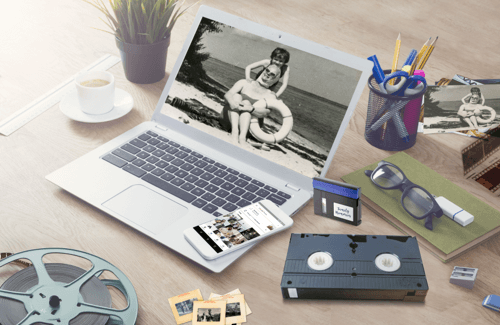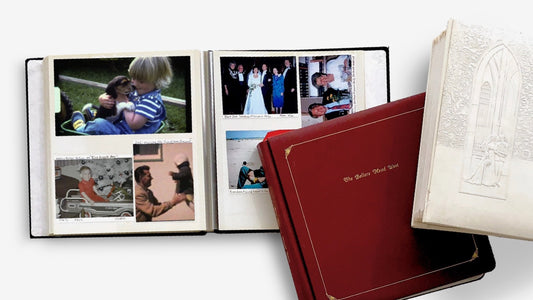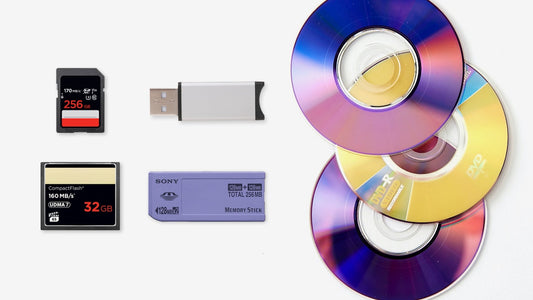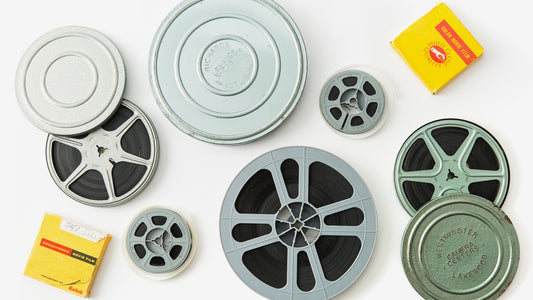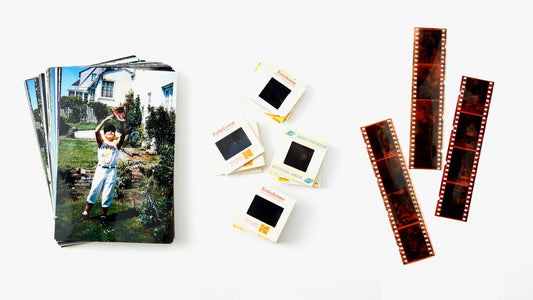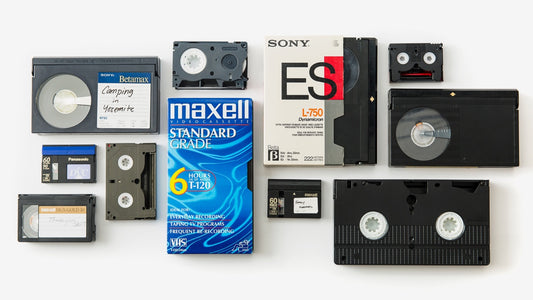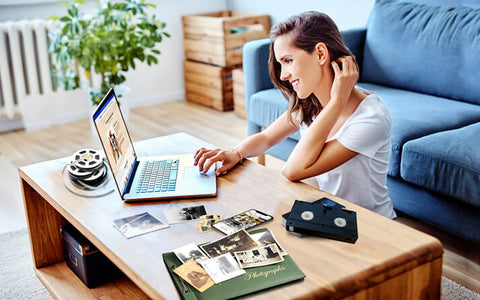Got boxes of old photo slides tucked away in an attic or closet? Those click-click-click memories hold a special kind of magic, but they're also incredibly delicate. Time, dust, and moisture can cause them to fade and degrade. That's where photo slide digitization comes in. It’s the best way to protect your family’s history from being lost forever. This guide will walk you through your options, comparing DIY methods with professional services. We'll cover everything you need to know—from prepping your slides to choosing the right digital format—so you can confidently preserve and share your memories.
Key Takeaways
- Protect your memories: Digitizing slides creates a safe backup, preserving them from damage and loss due to age, disasters, or deterioration. Professional services offer a convenient, high-quality option.
- Share with ease: Digital photos are simple to share online with loved ones, create albums, and use in various projects.
- Choose the best path for you: Balance your budget, time, number of slides, and quality needs to decide between DIY and professional digitization.
Why Should You Digitize Your Photo Slides?
Remember those carousel slide projectors and the click-click-click as each image flashed on the screen? Photo slides hold a unique charm, capturing moments in vibrant color and detail. But these delicate treasures are vulnerable to the ravages of time. Digitizing your slides not only preserves these precious memories but also breathes new life into them. Here's why converting slides to digital is so important:
Protecting your memories from fading, scratches, and deterioration is paramount. Slides are easily damaged by light, heat, humidity, and even dust. Digitizing creates a safe backup, ensuring your memories remain vivid for generations. Think of it as creating a master copy of your irreplaceable family history. Services like YesVideo safeguard your memories against floods, fire, and other unforeseen disasters.
Digitization also unlocks the potential of your memories. Once your slides are digital, sharing them becomes effortless. Imagine emailing photos to family, creating online albums, or even incorporating them into dynamic presentations. Converting slides to digital opens up a world of possibilities, allowing you to connect with loved ones and relive those special moments in exciting new ways. You can even explore options for digitizing home movies to create a comprehensive family archive.
Your Guide to the Best Photo Slide Digitization Methods
Want to bring your old photo slides into the 21st century? Digitizing those treasured memories is easier than you think. Whether you prefer a hands-on approach or want to leave it to the experts, there's a method that's right for you. Let's explore the best ways to digitize your photo slides.
The DIY Approach to Digitizing Slides
If you're feeling tech-savvy and enjoy a bit of a project, several DIY methods offer varying levels of control and investment.
-
Dedicated slide scanner: These specialized scanners are designed specifically for slides and negatives, offering the highest quality results for the DIY route. They can be a bit of an investment upfront, but if you have a large collection of slides, it might be worthwhile.
-
Flatbed scanner with a transparency adapter: Many flatbed scanners come equipped with a transparency adapter, allowing you to scan slides and negatives alongside documents and photos. This is a more budget-friendly option if you already own a compatible scanner. Just keep in mind, the quality might not be as high as a dedicated slide scanner. For tips on using a flatbed scanner, this article offers helpful advice on converting slides to digital images.
-
Digital camera and macro lens: For those with a DSLR or mirrorless camera and a macro lens, this method involves carefully photographing each slide. You'll need a steady hand, good lighting, and a bit of patience to get clear, focused images. Setting up a simple lightbox with a white background can really improve the results.
-
Slide projector and digital camera: This method involves projecting your slides onto a wall or screen and photographing the projected image. While this might seem simple, it can be tricky to achieve optimal focus and exposure. It's best for those who already have a projector and are comfortable with camera settings. This article provides a detailed guide on converting slides to digital using a projector and camera.
Using a Digital Camera and Macro Lens
If you already own a DSLR or mirrorless camera, this method can be surprisingly fast and deliver excellent results. Many photographers say it's the best DIY option because you're taking a high-resolution photo of each slide, not waiting on a slow scanner. The setup is straightforward: mount your camera on a tripod, attach a macro lens or a slide duplicator, place your slide in front of a light source, and snap the picture. It’s so efficient that some people have managed to digitize over a thousand slides in just a few evenings. This approach gives you fantastic control over the final image, but it does require some photography gear and a little practice to get right.
Using a Smartphone App
For a quick and accessible solution, you can turn to your smartphone. Several apps use your phone's camera to scan slides, making it a convenient option if you only have a few slides or a tight budget. You just hold your phone over the slide, and the app captures the image, often including tools to help crop and correct the color. While this method is great for a quick share on social media, it's important to know that the quality won't compare to a dedicated scanner. For your most irreplaceable memories, you'll want a higher-quality digital copy, which is where a professional photo transfer service can ensure your moments are preserved perfectly.
Hiring the Pros: Professional Digitization Services
If DIY isn't your style, or you have a large number of slides to digitize, professional services offer a hassle-free solution. Companies like YesVideo specialize in converting old media to digital formats, handling everything from scanning and color correction to organizing your digital files. They take the guesswork out of the process and ensure high-quality results, especially valuable for irreplaceable memories.
Turnaround Time Options
When you hand over your precious memories, it's natural to wonder how long it will take to get them back in their new digital format. With professional services, the turnaround time can vary. Most standard orders are completed in about a week, but this is just an estimate. The timeline really depends on the size of your slide collection and how busy the service is at that moment. A larger project with thousands of slides will, of course, take longer than a small batch. At YesVideo, every slide is handled with care by our team right here in the USA, so we take the time needed to ensure the highest quality. It's always a good idea to check the company's current processing times before sending in your order, especially if you have a specific deadline in mind for a gift or event.
Handling Special Film Types
Do you have a mix of different slides in your collection? You might have noticed that not all film looks the same. Professional digitization services are well-equipped to handle various 35mm slide types, including popular stocks like Kodachrome, Ektachrome, and Fujichrome. Each of these film types has a unique color profile and chemical composition, which can make them tricky to scan accurately without specialized equipment and expertise. This is where the pros really shine. They have the technology and experience to manage the specific color challenges of each film type, ensuring your digital images are true to the original vibrant colors you remember. This level of detail is difficult to achieve with most DIY setups, making a professional service a great choice for preserving the integrity of your special film.
A Closer Look at the Top Slide Conversion Services
Choosing a slide conversion service can feel overwhelming. To help you out, I've compiled a comparison of some popular options, highlighting what makes each one unique. The best choice for you depends on your specific needs and priorities.
YesVideo: A Review
YesVideo shines with its seamless integration with Google Photos. Your transfer purchase includes a digital copy, access to their MemoryCloud platform for viewing and downloading, and the option to save your memories directly to your Google Photos account. This simplifies sharing and organizing your photos. YesVideo also handles all orders by hand in the USA, providing an extra layer of care and quality control. You can learn more about their various digitization services, including video transfer, film transfer, photo transfer, album scanning, and digital media transfer on their website.
Our Process and Commitment to Quality
At YesVideo, we understand that your photo slides are more than just images; they're irreplaceable pieces of your family's story. That’s why our entire process is built on a commitment to quality and care. We use specialized, high-resolution scanners specifically designed for slides to capture the vibrant color and sharp detail in every frame. Our team of trained professionals handles each slide by hand, right here in the USA, performing individual cleaning and color correction. This meticulous approach ensures your final digital images are the best they can be. By choosing our photo transfer service, you're not just converting photos; you're creating a secure, lasting backup that protects your memories from fading and deterioration for generations to enjoy.
ScanMyPhotos: A Review
If speed is key, ScanMyPhotos is known for its quick turnaround times. They offer various scanning services for slides, negatives, and prints, making them a convenient option if you're digitizing multiple formats.
DigMyPics: A Review
DigMyPics offers high-resolution scanning up to 4000 dpi, ideal if image quality is your top priority. This detail allows for more flexibility when editing and cropping later. Keep in mind that higher resolution means larger file sizes. One point to consider from past reviews: while they carefully package the slides, their shipping materials have sometimes been less robust. You can read more about their process in this PCWorld review.
Legacybox: A Review
Legacybox emphasizes preserving the sentimental value of your memories and simplifying the digitization process. They offer a comprehensive service, handling various media types, including slides. Their focus on quality, security, and customer satisfaction makes them a reliable choice.
Memories Renewed: A Review
If personalized service matters to you, Memories Renewed might be a good fit. They're known for their attention to detail and individual customer support, which can be especially helpful if you have questions about your slides or the conversion process.
DIY vs. Professional Conversion: Which Is Right for You?
Digitizing your slides can feel like a big undertaking. One of your first decisions will be whether to do it yourself or hire a professional service. Both DIY methods and professional services have their own pros and cons. Let's break them down to help you decide which path best suits your needs and collection.
DIY Photo Slide Digitization: Pros and Cons
DIY slide digitization means converting your physical slides to digital images using your own equipment, usually at home. This gives you more control and can be a fun project if you enjoy hands-on work. Plus, it can be more budget-friendly upfront, especially if you already own a scanner. You can convert slides at your own pace, revisiting and adjusting as needed. Legacybox offers a helpful overview of this DIY approach.
However, DIY digitization requires an investment of time and effort. You'll need to research the best equipment, learn to use it, and dedicate time to scanning each slide. The quality of your digital images depends on your equipment and technical skills, and matching professional-grade results can be challenging. The process can also be time-consuming, especially with a large collection. Precious Memories discusses the time commitment involved in DIY digitization.
Professional Slide Conversion: Pros and Cons
Professional slide conversion services, like those offered by YesVideo, take the hassle out of digitizing slides. Experts handle the entire process, from carefully handling your slides to using high-quality equipment for optimal image quality. You'll save time and effort, knowing your memories are in good hands. Contrastly discusses the advantages of professional services for high-quality results.
The primary drawback of professional services is the cost. While prices vary depending on the service and the number of slides, it's typically more expensive than DIY. Turnaround time can also be a factor, as professional services often have queues and processing times. However, for those who value convenience, high-quality results, and peace of mind, the investment can be worthwhile. Reference.com offers a helpful cost comparison between DIY and professional services.
How Much Does Slide Conversion Cost?
So, you're ready to bring those treasured memories trapped on slides into the digital age. A critical part of that decision is figuring out your budget. Let's break down the costs associated with slide conversion, looking at both DIY and professional options.
What You'll Spend on DIY Equipment
If you're a hands-on type and enjoy tackling projects yourself, the DIY route might appeal to you. Digitizing slides yourself usually involves purchasing a slide scanner and potentially some photo editing software. Basic slide scanners typically cost between $100 and $300, while higher-end models with advanced features can set you back upwards of $500. Factor in the cost of software, and your initial investment can add up. While this might seem pricey upfront, the cost per slide decreases the more slides you have. This makes DIY a potentially cost-effective option for large collections if you’re comfortable with the technical side of things.
High-End Scanner Setups
For those serious about achieving professional-grade quality at home, a high-end scanner setup is the next level up. This often means investing in a dedicated slide scanner, a machine built specifically for one job: digitizing slides and negatives with exceptional detail and color accuracy. The price tag reflects this specialization; some models can run over a thousand dollars, not including accessories like slide feeders or specialized software. This significant investment makes the most sense if you have a massive collection of slides and the technical confidence to manage the process. Another high-quality route is using a DSLR camera with a macro lens, which requires some photography know-how but can produce excellent results. These methods offer the ultimate control but also demand the most from your wallet and your time.
Understanding Professional Service Costs
For those who prefer a hassle-free experience or lack the time for a DIY project, professional slide conversion services are a great alternative. Companies like YesVideo offer slide scanning services, and their pricing is generally calculated per slide. Pricing structures vary between providers; some, like Costco, offer package deals that can be more economical for larger quantities. This per-slide pricing makes it easy to estimate the total cost based on the size of your collection. Professional services often include color correction and image enhancement, giving you more bang for your buck. If you have a smaller collection or value convenience and professional results, this might be the better choice.
Per-Slide vs. Item-Based Pricing
When you opt for a professional service, you'll find that most companies charge on a per-slide basis. This straightforward pricing model makes it easy to estimate your total cost—simply multiply the number of slides you have by the per-slide rate. For instance, a service like YesVideo calculates the cost this way, which helps you budget effectively before you even send your memories in. Some services may also offer tiered pricing, where the cost per slide decreases as your quantity increases, making it more economical for those with substantial family archives. This item-based approach ensures you only pay for what you need digitized, providing clarity and control over the final expense.
Additional Costs for Storage Media
It's important to remember that the per-slide scanning fee might not be the final price. After your slides are digitized, you'll need a way to receive and store your new digital files. Most services offer several options, which usually come with an additional cost. You might choose to have your photos saved on a USB drive, a DVD, or delivered via a cloud-based service. For example, you could pay around $10 for a USB drive or a bit less for a set of DVDs. Some companies, including YesVideo, provide a digital download and temporary cloud storage with your purchase, giving you immediate access to your memories and a chance to share them before your physical media even arrives.
A Tip for Large Projects: Share the Expense
If you're looking at a mountain of slide carousels, the total cost of professional digitization can feel daunting. But here's a practical idea: treat it as a family project. Since these memories belong to everyone—your parents, siblings, aunts, and uncles—consider pooling your resources to cover the expense. Digitizing a shared family history is a gift to every member, preserving your collective legacy for future generations to enjoy. By collaborating with relatives, you can make a high-quality professional service much more affordable, ensuring those irreplaceable moments are preserved without placing the financial burden on one person.
Achieving the Best Results with Photo Slide Digitization
Getting the best results when you digitize slides takes a little planning. These tips will help you get high-quality images, whether you're tackling the project yourself or hiring a professional service like YesVideo.
How to Prepare Your Slides for Scanning
Before you even think about scanning, gently clean your slides. Dust, fingerprints, and smudges can affect the final image quality. A soft, lint-free cloth is usually enough. For stubborn marks, use a specialized cleaning solution designed for film. If your slides are in plastic sleeves or carousels, organize them into manageable groups. Keeping bundles to around 50 slides or less prevents rubber bands from snapping and potentially damaging your memories. Larsen Digital offers helpful advice on preparing slides for digital conversion.
The Importance of Dust Removal
Taking a moment to clean your slides before scanning is one of the most impactful steps you can take. Dust, fingerprints, and tiny smudges might seem minor, but they can appear as distracting spots and blemishes on your final digital photos. The best way to handle this is to use a dust blower, which gently clears away debris without you having to touch the slide's delicate surface. This simple action can save you hours of tedious editing work down the road. A thorough cleaning also helps produce scans with better color, sharpness, and contrast, making sure your memories look their absolute best. It’s a non-negotiable step for professional services and just as critical for any DIY project.
What's the Best Resolution for Scanning Slides?
Resolution matters. It determines the level of detail captured in your digital images. Higher resolution scans create larger files and preserve more detail—great for enlarging or printing. However, they also require more storage space. If you're primarily sharing photos online or viewing them on a screen, a lower resolution might suffice. Consider how you plan to use your digitized photos when making your decision.
Common Resolution Options from a Pro Service
When you opt for a professional service, you'll typically encounter a few resolution choices. Think of resolution, measured in DPI (dots per inch), as the amount of detail captured in your digital image. A higher DPI creates a sharper, clearer photo, which is ideal if you dream of making large prints or cropping in on specific details. For instance, some services offer scans up to 4000 DPI for incredible clarity. At YesVideo, we scan slides at a high resolution of 9 megapixels (around 3400 DPI) to ensure your memories are preserved in beautiful high definition.
A standard resolution, often around 2400 DPI, is perfectly fine for most uses, like sharing photos online or viewing them on a digital frame. This gives you a great balance between quality and file size, so your digital memories won't eat up all your storage space. As this PCWorld review of digitizing services highlights, different companies cater to different priorities. Considering how you plan to enjoy your photos will help you pick the resolution that’s just right for you.
Editing Your Scans for a Perfect Finish
Once your slides are scanned, you might want to enhance them further with photo editing software. Simple adjustments like brightness, contrast, and color correction can make a big difference. For more serious issues like mold or damage, consider professional photo restoration. A trained specialist can often work wonders, rebuilding damaged areas and restoring your slides. Contrastly offers insights into more advanced photo restoration. Remember, digitizing your slides is just the first step in preserving your memories. Taking the time to prepare, choose the right settings, and consider post-processing ensures your digital images look their best for years to come.
Slide Conversion Pitfalls (and How to Avoid Them)
Digitizing slides can feel like a delicate process, and understandably so! These memories are precious. Here are a few common mistakes to avoid so you can get the best possible results:
Avoiding Low-Quality Scans
Using the wrong equipment or incorrect settings can lead to blurry, pixelated, or poorly exposed digital images. Investing in a high-quality scanner or choosing a reputable professional slide scanning service is key for sharp, vibrant digital copies that truly capture the original slide's beauty. Remember, you're preserving these memories for future generations, so quality matters. As the experts at Smooth Photo Scanning point out, manual slide conversion can be time-consuming and prone to errors, highlighting the need for proper equipment and techniques.
A Warning About Carousel-Based Scanners
The idea of a carousel-based scanner sounds like a dream, right? You load up your slides, press a button, and walk away. Unfortunately, the reality is often less than ideal. While it might seem like a convenient, automated fix for a big box of slides, these scanners have a reputation for being slow and producing lackluster quality. Many photography enthusiasts have found that even high-end, semi-automated models are surprisingly sluggish and come with a steep price tag. For the time and money you might invest, you could often achieve better, faster results using a digital camera with a macro lens. So, before you commit to a carousel scanner, be aware that it might not be the efficient, high-quality solution you're hoping for when it comes to protecting your precious memories.
Forgetting to Check Slide Condition
Before you even begin scanning, take a moment to assess the condition of your slides. Dust, scratches, and fading can impact the final digital image. Cleaning your slides gently with a soft cloth or a specialized cleaning solution can make a big difference. For slides with significant damage, consider professional restoration services after scanning. This extra step can breathe new life into faded or damaged images, as noted by Contrastly in their guide on slide conversion.
Skipping the Cleaning Step
Even seemingly minor dust or fingerprints can show up as noticeable blemishes on your digital images. Clean each slide carefully with a soft brush or compressed air before scanning. For stubborn dirt, a specialized cleaning solution designed for film can be helpful. This simple step can significantly improve the quality of your digital conversions.
Bundling Your Slides Incorrectly
If you're working with a large number of slides, proper organization is essential. Avoid using rubber bands to bundle slides, as they can degrade over time and damage your precious memories. Instead, opt for archival-safe sleeves or boxes designed specifically for slides. Larsen Digital recommends bundling no more than 50 slides at a time to prevent damage, ensuring a smoother and safer conversion process.
Choosing a Conversion Method: Factors to Consider
Deciding how to convert your slides—DIY or professional service—depends on a few key factors. Thinking through these upfront will help you make the best choice for your needs and budget.
How Many Slides Do You Have?
The sheer number of slides you're dealing with plays a big role in your decision. A small collection might be manageable to digitize yourself, but a large collection could quickly become overwhelming. If you only have a handful of slides, a DIY approach might be perfectly reasonable. But for hundreds or even thousands of slides, the time investment alone can be significant. Professional slide scanning services are often better equipped to handle large volumes efficiently. Consider how many slides you have and whether you realistically have the time and resources to tackle them all yourself.
How Much Time Can You Commit?
Be realistic about how much time you can dedicate to this project. Digitizing slides yourself requires purchasing or renting equipment, learning how to use it, and dedicating blocks of time to the actual scanning process. If you’re short on time, using a professional service might be the best use of your resources. While there's still a time investment involved in organizing and sending your slides, you won't be responsible for the hands-on conversion work. Think about your schedule and how much effort you're willing to put in.
Estimating the Time for a Large DIY Project
Let's be realistic about what a large DIY project entails. Digitizing hundreds, or even thousands, of slides yourself is a big project that can take many months, or even a year, if you're only able to work on it a few hours a week. It’s often described as tedious but rewarding. This timeline isn't just for the scanning part—it also includes the initial learning curve of researching and mastering your equipment. While having full control over the process is a major plus for some, it's crucial to go in with a clear understanding of the significant time commitment required to see a large collection through to the end.
What Level of Quality Do You Need?
Think about your desired image quality. Are you aiming for simple digital copies, or do you want to restore faded colors and repair minor damage? If you have treasured slides with sentimental value, professional services often offer image restoration expertise that can significantly enhance the final results. They can often address issues like color correction, dust removal, and even minor tear repair. If achieving the highest possible quality is important to you, a professional service might be the better option.
What's Your Budget?
Finally, consider your budget. DIY methods might seem cheaper upfront, but factor in the cost of a scanner (or renting one), software, and your time. Professional services charge per slide or per batch, so get a few quotes to compare pricing. Weigh the cost against the value of your time and the quality you expect. Sometimes, the peace of mind and expertise offered by a professional service are worth the investment. Consider what you're comfortable spending and what level of quality you're willing to pay for.
Your Slides are Digitized: What's Next?
After converting your slides to digital images, proper storage, sharing, and protection are essential for these precious memories. Here’s how to make the most of your newly digitized photos:
Where to Safely Store Your Digital Photos
Think beyond your computer’s hard drive. Cloud storage services like Google Photos offer secure and accessible storage for your images. YesVideo integrates with Google Photos, making backing up your memories simple. This protects your photos from computer crashes and makes them accessible from any device. For convenient access and organization, consider an external hard drive or a USB flash drive.
The Best Ways to Share Your Photos with Family
Sharing your digitized slides is easier than ever. Create online albums for family and friends or use social media to showcase favorite memories. Services like MemoryCloud offer a platform for viewing, downloading, and sharing photos. You can also email individual images or create slideshows for digital sharing.
Don't Lose Your Photos: Simple Backup Strategies
A solid backup strategy is crucial. The 3-2-1 method is reliable: keep three copies of your photos on two different media types, with one copy stored offsite. This could involve your computer, an external hard drive, and a cloud storage service. This redundancy ensures your digitized slides remain safe, even with device failure or a natural disaster. Regularly backing up your files protects your digital images from data loss.
Answering Your Top Slide Conversion Questions
Let's face it, handing over boxes of precious memories can feel a little nerve-wracking. It's natural to have some concerns. This section addresses those common worries, so you can approach slide digitization with confidence.
Will My Original Slides Be Safe?
One of the biggest concerns when digitizing slides is the safety of your originals. You want to be sure they'll be handled with care and returned to you unscathed. A reliable service will prioritize the safe handling and return of your slides. Look for clear communication about their packaging and shipping procedures. Ideally, your slides should be packed in protective materials and shipped in sturdy packaging to prevent damage. While some services may use soft envelopes, a rigid box offers better protection against bending or crushing. Reading customer reviews can offer valuable insights into a company's handling practices. For example, in a PCWorld review of photo digitization services, one user noted their slides were returned in zip-lock bags within a soft envelope, highlighting the importance of careful consideration of a service's shipping methods. At YesVideo, we understand this concern and take every precaution to ensure your originals are returned to you safely. We use protective materials and sturdy boxes for all shipments.
How YesVideo Keeps Your Memories Secure
It’s completely normal to feel a little protective of your family's slides—they're irreplaceable! At YesVideo, we've built our entire process around that understanding. With over 20 years of experience, we’ve become the most trusted name in digitization because we treat every memory as if it were our own. Every single order is carefully processed by hand right here in the USA by our team of trained experts. This hands-on approach ensures your slides receive the individual attention they deserve, from the moment they arrive at our facility to the moment they're safely returned to you.
Tracking, Guarantees, and Digital Backups
For extra peace of mind, we have several layers of security in place. From the moment your order arrives, we use a barcode system to track your memories throughout the entire digitization process, so nothing ever gets misplaced. Our commitment to quality is our guarantee to you. Plus, once your slides are digitized, we provide access to your photos on our secure MemoryCloud for 90 days. This gives you a safe digital backup and plenty of time to download, save, and share your photos without rushing. It’s all part of how we ensure your memories are protected from start to finish.
Will the Digital Copies Look Good?
Of course, you want your digital images to look their best. Image quality is paramount. Several factors influence the final result, including the scanning equipment, the resolution, and any post-processing work. Converting slides manually can be time-consuming, increasing the risk of errors. A professional service utilizes high-quality scanners and efficient workflows to minimize these risks. However, even with the best equipment, some images may benefit from restoration work, especially if the original slides are faded or damaged. Articles discussing the challenges and solutions in slide conversion offer helpful insights into maintaining image quality. YesVideo prioritizes quality and uses professional-grade equipment to ensure your digital images are crisp, clear, and capture the vibrancy of your original slides. We also offer photo restoration services to further enhance your images.
The Role of Manual Color Correction
Over the years, the colors in your slides can fade or shift, leaving them with a reddish or bluish tint. This is where manual color correction comes in. Unlike automated software that can sometimes miss the mark, a trained technician reviews each image by hand. This individual attention ensures that colors are restored to their original vibrancy, adjusting for the best possible sharpness and contrast. Professional services often include this detailed image enhancement, which is a huge part of what makes the final digital copies look so good. At YesVideo, our technicians manually correct each slide, bringing back the rich tones and details you remember. This careful process helps ensure your digitized memories are as vivid and beautiful as the day they were captured.
Which Digital File Format Is Best?
Once your slides are digitized, you'll need to understand the different file formats available. Two common formats are TIFF and JPEG. TIFF is a lossless format, meaning it preserves all the image data, making it ideal for archival purposes. JPEG, on the other hand, is a compressed format that results in smaller file sizes, making it more suitable for sharing online or viewing on devices. Understanding the pros and cons of each format will help you make an informed decision about how to store and share your photos. YesVideo offers options for both formats, giving you flexibility.
Understanding JPG vs. TIFF Files
Once your slides are digitized, you'll typically choose between two main file formats: JPG (or JPEG) and TIFF. Think of a TIFF file as your digital master copy. It's a "lossless" format, meaning it saves every bit of image data without compression, preserving the highest possible quality. This makes TIFF the best choice for archival purposes or if you plan to make large prints or do detailed photo editing. In contrast, a JPG is a "compressed" format that creates a much smaller file size, making it perfect for everyday use. JPGs are easy to share with family via email, post on social media, or view on your phone or tablet. Knowing the difference will help you choose the right format for how you plan to use and store your newly digitized memories.
Related Articles
- Photo Slides: A Comprehensive Guide (2023) – YesVideo
- YesVideo's Photo Digitization - Digitize Old Slides, & More
- Top 6 Photo Scanning Services to Preserve Your Memories – YesVideo
- Cassette to Digital: Your Ultimate Conversion Guide – YesVideo
- Memories Made Digital | Tips & Stories from the YesVideo Blog
Frequently Asked Questions
What are the benefits of digitizing my photo slides? Digitizing slides protects them from damage and deterioration, allowing you to preserve those memories for years to come. It also makes sharing and enjoying your photos much easier – you can email them, create online albums, or even use them in presentations. Plus, you'll have a secure backup in case anything happens to the originals.
What's the best way to digitize slides? The best method depends on your needs and resources. DIY methods like using a scanner or your digital camera offer more control and can be budget-friendly, but they require more time and effort. Professional services are convenient and offer high-quality results, but they come at a cost. Consider your budget, the number of slides you have, and your comfort level with technology when making your decision.
How much does slide conversion cost? DIY costs involve purchasing a scanner, which can range from around $100 to over $500 for high-end models. Professional services typically charge per slide or by the batch, with prices varying depending on the company and any additional services like color correction or restoration. Get a few quotes to compare pricing and find the best fit for your budget.
What are some common mistakes to avoid when digitizing slides? One common mistake is neglecting to clean your slides before scanning. Dust and fingerprints can significantly impact the quality of your digital images. Another mistake is using improper storage methods, like rubber bands, which can damage slides over time. Finally, not having a backup plan for your digital files is a risk you shouldn't take. Whether you’re working with slides or looking to digitize photos, always use external hard drives, cloud storage, or multiple devices to ensure your memories stay safe.
What should I do with my digitized photos? Once your slides are digitized, store them securely using cloud storage, external hard drives, or USB drives. Share them with family and friends through online albums, social media, or email. Most importantly, back up your digital files regularly to protect against data loss. The 3-2-1 backup method (three copies on two different media types, with one offsite) is a reliable strategy.




